Archived - GBA+: Chapter 2
GBA+: Chapter 2
Building Strong Communities
New Infrastructure Funding For Local Communities through a Municipal Top-Up
- $ 2.2 billion in 2018–19 through the Gas Tax Fund to help build and revitalize public infrastructure in municipalities and First Nations communities.
The federal Gas Tax Fund supports thousands of infrastructure projects each year in communities across Canada.
The program supports a broad range of infrastructure assets, such as local roads and bridges, public transit and water systems, which are expected to benefit all Canadians. These investments will support productivity and economic growth and strong cities and communities.
In the short term, the construction of infrastructure projects is expected to carry more indirect benefits for men, who represent over 80 per cent of the total construction workforce. There will be also benefits for occupations related to the construction industry, such as architects and urban planners, in which women are strongly represented.
GBA+ was performed: On the existing program
Target population: All Canadians
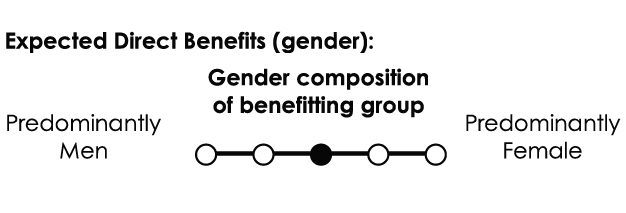
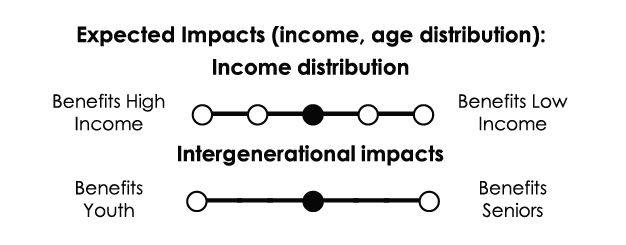
GBA+ Responsive Approach
GBA+: Chapter 2
Affordable Electricity Bills and a Clean Economy
Making Zero-Emission Vehicles More Affordable
- Up to $130 million over five years to advance Canada’s zero-emission vehicle (ZEV) charging and refuelling infrastructure network in workplaces, public parking, commercial and multi-unit residential buildings and remote locations.
- Up to $300 million over three years to introduce a new federal purchase incentive of up to $5,000 for electric battery or hydrogen fuel cell vehicles with a manufacturer’s suggested retail price of less than $45,000.
- $5 million over five years to work with auto manufacturers to secure voluntary ZEV sales targets to ensure that vehicle supply meets increased demand.
- Automotive manufacturers and parts suppliers can access funding through the Strategic Innovation Fund, which was recently provided $800 million in additional funding through the 2018 Fall Economic Statement.
Transportation accounts for about 24 per cent of Canada’s greenhouse gas emissions, mainly coming from cars and trucks. Zero-emission vehicles are battery electric, plug-in hybrid and hydrogen fuel cell vehicles that have the potential to significantly reduce greenhouse gas emissions from the transportation sector. A number of barriers exist to increasing their deployment in Canada.
Available research indicates that the current demographics of early adopters of ZEVs in Canada are more likely to be well-educated (three times more likely to have a graduate degree), and high-income earners (five times more likely to make over $125,000). The proposal may not benefit individuals in northern Canada due to colder climates and infrastructure limitations, or those with low incomes or mobility issues.
Over time, as consumer comfort with ZEVs increases, and they become more affordable and more readily available to consumers, researchers expect that future ZEV vehicle purchasers would reflect the general vehicle-owning population, namely individuals of diverse language, education levels, marital status and culture.
Longer-term environmental benefits from potential reductions in greenhouse gas emissions and air pollutants are expected to benefit all Canadians.
GBA+ was performed: Early in the idea development phase
Target population: Current and upcoming vehicle owners and the Canadian auto manufacturing sector
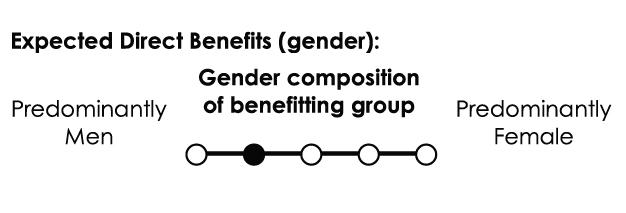
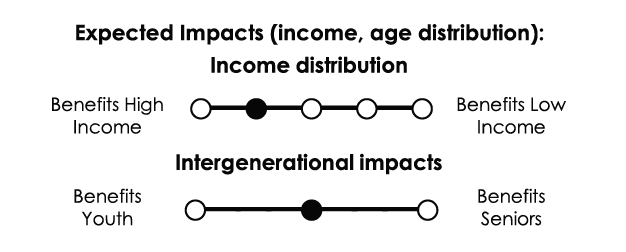
GBA+ Responsive Approach
GBA+: Chapter 2
Affordable Electricity Bills and a Clean Economy
Supporting Business Investment in Zero-Emission Vehicles
- Provide an enhanced first-year allowance of 100 per cent, subject to a phase-out, in respect of zero-emission motor vehicles. In addition, the capital cost limit of $30,000 applicable to passenger vehicles will be increased to $55,000 in respect of zero-emission passenger vehicles.
The replacement of a number of gas-powered vehicles with zero-emission vehicles (ZEVs) by businesses is expected to help Canada’s business sector green its operations, increase its efficiency and bring broad environmental and health benefits for all Canadians.
These benefits could increase in the long term if increased demand for ZEVs leads to improvements in infrastructure, which in turn could lead to more widespread adoption of ZEVs.
The increased use of ZEVs can also result in health benefits through improved air quality. These benefits would accrue to all individuals, in particular those residing in urban and suburban areas (over 80 per cent of Canadians).
The tax savings arising from this measure may disproportionally benefit shareholders from businesses acquiring zero-emission vehicles, who tend to be men and/or in higher-income brackets, as well as older individuals, who are overrepresented among taxable shareholders. For example, men receive a higher share of dividends overall (60 per cent of the total value of all dividends in 2016).
GBA+ was performed: Mid-point
Target population: Business sector
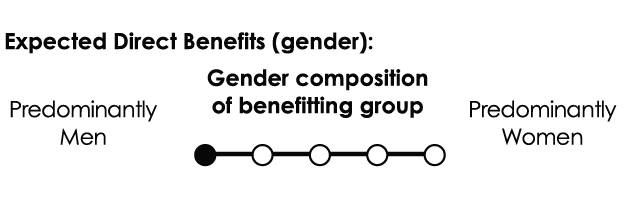

GBA+: Chapter 2
Affordable Electricity Bills and a Clean Economy
Reducing Energy Costs Through Greater Energy Efficiency
- $1.01 billion in 2018–19 to the Federation of Canadian Municipalities to increase energy efficiency in residential, commercial and multi-unit buildings, and to improve asset capacity management.
Using energy to heat and cool buildings accounts for over 12 per cent of national greenhouse gas (GHG) emissions. Emissions from buildings are projected to grow modestly by 2030 unless action is taken to improve the energy efficiency of buildings. Improving energy efficiency can increase comfort, support healthier living and reduce GHG emissions to help Canada meet its climate change target and help lower energy bills.
The initiative will directly benefit all Canadians by increasing energy efficiency in residential, commercial and multi-unit buildings as well as affordable housing. It will also help to address climate change, the impacts of which disproportionally impact women in Canada and around the world. The investment will be allocated to three areas as follows:
Community EcoEfficiency Acceleration will support home energy retrofits in municipalities. The homeownership rate in Canada was 67.8 per cent in 2016. Homeownership is strongly correlated to age and income, with ownership rates increasing with age and income.
Sustainable Affordable Housing Innovation will support energy efficiency retrofits and onsite energy generation at new and existing affordable housing developments run by municipalities and non-municipal organizations. In 2016, 12.7 per cent of Canadians were in core housing need. Nearly half of public affordable housing is owned by municipalities, which is predominantly concentrated in urban municipalities.
GBA+ was performed: On the existing program
Target population: All Canadians


Since 2000, only 5.2 per cent of public affordable housing structures have been constructed.
Collaboration on Community Climate Action will help Canadian municipalities, including small and rural communities, increase their energy efficiency through innovative community projects that facilitate energy retrofits in residential and commercial buildings.
These investments are expected to carry more indirect benefits for men, who represent over 80 per cent of those employed in skilled trades related to energy efficiency retrofits.
In addition, $60 million will be invested in 2018–19 in the Federation’s Municipal Asset Management Capacity Fund to help small communities get skills training on how to inventory, grow and maintain infrastructure assets.
GBA+ Responsive Approach
GBA+: Chapter 2
Affordable Electricity Bills and a Clean Economy
A Just Transition for Canadian Coal Power Workers and Communities
- $150 million over five years, starting in 2020–21, to establish an infrastructure fund for affected communities.
Many workers in the coal industry live in areas where other opportunities for economic development are limited. According to the Task Force on Just Transition for Canadian Coal Power Workers and Communities, workers in the coal sector tend to be primarily older men.
The Government is proposing, through Budget 2019, to explore ways to protect wages and pensions of workers who may be retiring earlier than anticipated.
New infrastructure funding can help communities diversify their economic base and act on new opportunities, while also creating short-term employment.
Specific outcomes of these measures for different groups (workers, all residents of communities) will depend on the projects chosen.
GBA+ was performed: Later stage
Target population: Workers in thermal coal mining or coal-powered electricity-generating stations, and residents of communities reliant on these industries and facilities


GBA+ Responsive Approach
GBA+: Chapter 2
Affordable Electricity Bills and a Clean Economy
Improving Canadian Energy Information
- $15.2 million over five years, with $3.4 million per year ongoing, to develop a virtual Canadian Centre for Energy Information.
Canada has a diverse energy mix, and responsibility for energy data collection is fragmented and spread across multiple sources, including provincial and federal governments.
Canadians benefit from comparable and consolidated energy data as this contributes towards better decision-making by governments and industry, and supports higher quality research.
Currently, energy data are mostly available only to individuals working in the private sector or undertaking research in the science, technology, engineering and mathematics (STEM) field, who are predominantly men. The virtual Canadian Centre for Energy Information will provide free access to energy data for all Canadians, which will help improve access for students, researchers, NGOs, women and other groups who may currently lack access to this information.
As part of the measure, work will be undertaken to identify data gaps that will improve the overall quality of energy information available to all Canadians.
GBA+ was performed: Early in the idea development phase
Target population: All Canadians


GBA+: Chapter 2
Connecting Canadians
Access to High-Speed Internet for all Canadians
- Up to $1.7 billion over 13 years, starting in 2019–20, for new investments to help achieve universal access to high-speed internet.
- Up to $11.5 million for five years, starting in 2019–20, to measure household and business access and use of the internet.
Virtually all Canadians have some level of internet access, regardless of where they live. However, access to reliable high-speed internet does not exist in many rural, remote and northern communities, creating a digital divide. Only 39 per cent of households in rural areas have access to internet speeds of 50/10 megabits per second (Mbps) compared to 100 per cent of households in large urban areas.
By investing in projects to bring high-speed internet to underserved communities, the proposal aims to improve economic and social opportunities for Canadians living in these regions, including youth, women, seniors and Indigenous peoples. Over 1.5 million households do not have reliable access to internet speeds of 50/10 Mbps, including more than 100,000 Indigenous households.
The opportunity to download and upload data at a faster speed allows people to make better use of online services and applications, such as distance education tools, e-healthcare, commerce and government services, which can have a material benefit on their socio-economic well-being.
Internet adoption rates are nearly identical between men and women, with 80.2 per cent of men using the internet compared to 79.9 per cent of women.
GBA+ was performed: On the existing program
Target population: Canadians who live in rural, remote and northern communities

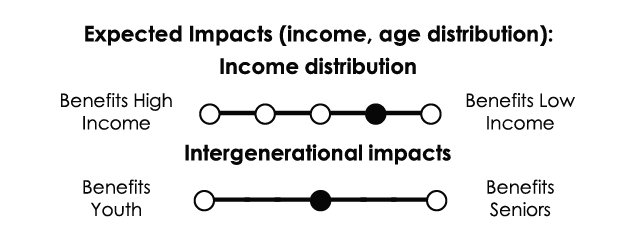
GBA+ Responsive Approach
GBA+: Chapter 2
Building a Better Future for Canada's North
Strong Arctic and Northern Communities
- Over $700 million over 10 years towards a range of measures including enhanced economic development programming, infrastructure, a task force on post-secondary education in the North and increased funding for the Dechinta Centre for Research and Learning.
Socio-economic outcomes continue to be lower for residents of Canda’s Arctic and northern regions. According to Statistics Canada, Indigenous northerners especially suffer lower life expectancies, along with poorer health and socio-economic outcomes. Transportation costs are relatively high for northerners, given minimal road access and the heavy reliance on air travel for community resupply and to access distant markets. Residents of the North also tend to be younger than in the rest of Canada.
Several initiatives directed towards this region of Canada included in Budget 2019 are expected to have positive impacts for Indigenous peoples and youth, with neutral to positive impacts for northern communities more broadly. Other proposed measures for funding are not anticipated to result in differential impacts.
Enhancing economic development programming would likely have positive impacts on increasing the participation of underrepresented people in the economy, especially youth, women and Indigenous peoples. As with infrastructure support, this programming is expected to lead to positive indirect impacts for all northerners.
Support for a task force and increased funding for the Dechinta Centre is expected to have positive impacts on youth and Indigenous peoples, by leading to more accessible and culturally appropriate post-secondary educational options.
GBA+ was performed: At varying stages of development, from early development to existing programs
Target population: All residents of Arctic and northern communities, with an emphasis on Indigenous Peoples and youth

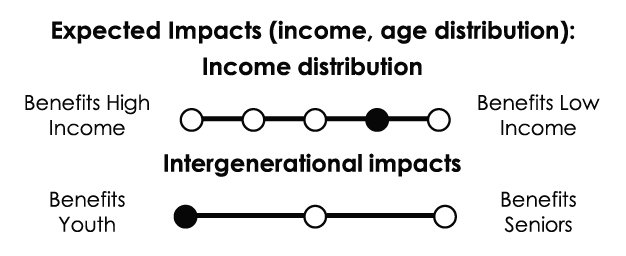
 More diversified educational paths and career choices
More diversified educational paths and career choices
GBA+ Responsive Approach
GBA+: Chapter 2
Building a Better Future for Canada's North
Expanding Clean Electricity in Northern Communities
- $18 million, over three years, starting in 2019–20, to Crown-Indigenous Relations and Northern Affairs Canada to support planning by the Government of Northwest Territories for its proposed Taltson hydroelectricity expansion project.
The project would provide 60 megawatts of hydroelectricity on an already developed river (Taltson River), with power generation commencing within five to ten years. It would be co-located with an existing run-of-river facility and would not require any flooding of the land. By 2040, an additional 55 megawatts could be developed for a total expansion of 115 megawatts. The Taltson River system could support a total generation capacity of 200 megawatts, and would provide the extra power needed for projected territorial population expansion.
Partnerships with Indigenous groups are expected, and the Government of the Northwest Territories is committed to keeping its record of positive Indigenous collaboration. To date, discussions have taken place with the Akaitcho, the Salt River First Nation, and the Northwest Territory Métis Nation
GBA+ was performed: Early in the idea development phase
Target population: Northern (including Indigenous and remote) communities


GBA+: Chapter 2
Building a Better Future for Canada's North
Cleaning Up Northern Abandoned Mines
- $49.9 million over 15 years ($2.2 billion on a cash basis), starting in 2020–21, to clean up and manage the largest and highest-risk contaminated sites in the North.
Cleaning up abandoned mines in the North will benefit persons living in northern communities by providing them with a cleaner and healthier environment. The remediation of contaminated sites also offers socio-economic opportunities to northern communities, including job opportunities that require skills that are highly transferable to other sectors of the economy (e.g., mining, construction).
The employment and training opportunities generated by managing and remediating northern contaminated site projects tend to indirectly benefit men at a higher rate than women as the types of jobs and skills required (e.g., construction, engineering) are fields that are generally predominantly men. Indigenous peoples are also currently underrepresented in the educational programs required for these jobs.
Between 2010 and 2017, women benefitted from 24 per cent of the employment hours and 21 per cent of the training hours related to the program, and Indigenous peoples benefitted from 20 per cent of the employment hours and 46 per cent of the training hours.
GBA+ was performed: On the existing program
Target population: Residents of northern communities


GBA+ Responsive Approach
GBA+: Chapter 2
Investing in Other Regional Priorities
Protecting Water and Soil in the Prairies
- Budget 2019 proposes to provide up to $1.0 million in 2019–20 to Western Economic Diversification Canada to develop a strategy for addressing the impacts of climate change on water resources within the provinces of Alberta, Saskatchewan, and Manitoba, with a focus on agricultural lands.
The funding being considered will be used to fund research, engagement, and consultation among federal departments with a view towards developing a strategy for addressing the impacts of climate change on water resources within the provinces of Alberta, Saskatchewan, and Manitoba, with a focus on agricultural lands.
Given that the proposal is to develop a strategy, no direct or negative impacts are anticipated from this proposal. Should the strategy result in action, Canadians residing in the provinces of Alberta, Saskatchewan, and Manitoba, would be expected to benefit, with farmers and ranchers in the prairie receiving the largest benefits. 49.8 per cent of inhabitants of the prairie provinces are women, and of the three provinces, Manitoba has the highest percentage of women at 50.1 per cent.
GBA+ was performed: Early in the idea development phase
Target population: Canadians residing in the provinces of Alberta, Saskatchewan, and Manitoba.


GBA+ Responsive Approach
GBA+: Chapter 2
Investing in Other Regional Priorities
Investing in Eastern Canada Ferry Services
- Funding to maintain and extend safe and reliable interprovincial ferry services in eastern Canada.
Every year, federally funded ferry services offered by Marine Atlantic Inc. and Transport Canada’s Ferry Services Contribution Program in eastern Canada help transport more than 800,000 passengers and 100,000 commercial vehicles safely and reliably. The services increase accessibility for 2.4 million Canadians residing in the Atlantic provinces and the remote community of Îles de la Madeleine, Quebec, by increasing the mobility of the residents and the flow of essential goods.
Extending the Ferry Services Contribution Program to 2022 and procuring new ferries will continue to support locales in eastern Canada and commercial users, as well as tourism for years to come. The procurement of new ferries will ensure the services remain safe and reliable.
Marine Atlantic Inc. ferry services are dominated by commercial traffic (primarily male passengers), which provides goods and services benefiting local residents. Passengers using services funded by the Ferry Services Contribution Program are broadly balanced from a gender perspective.
Indirectly, the maintenance of current service levels supports Canada’s maritime workforce, which is primarily composed of men. For example, in 2018, men represented 63 per cent of Marine Atlantic Inc.’s crew staff.
GBA+ was performed: Early in the idea development phase and on an existing program
Target population: Canadians residing in Atlantic provinces and Îles de la Madeleine, Quebec


GBA+ Responsive Approach
GBA+: Chapter 2
Investing in Other Regional Priorities
Improving Crossings in Canada’s Capital Region
- $80.4 million over ten years to support the rehabilitation and ongoing maintenance of National Capital Region crossings, including the Chaudière and McDonald Cartier Bridges.
The interprovincial bridges serve as an important transportation link between the city cores of Ottawa and Gatineau and form part of the National Capital Commission’s Ceremonial Route.
The five interprovincial crossings carry close to 150,000 vehicles and 9,000 pedestrians and cyclists each day, an increase of over 15,000 since 2015 alone.
Improving crossings in Canada’s Capital Region, including the Alexandra Bridge, will particularily benefit individuals in the Ottawa/Gatineau region who use one of these bridges to commute to work daily, notably Quebec residents who work in Ontario. Indirect benefits are expected to go to those in the construction and related industries, which tend to be predominatly men. Women made up 14 per cent of workers in the construction industry in 2017.
Roughly 11 per cent of all morning peak traffic is interprovincial (8 per cent from Quebec to Ontario and 3 per cent from Ontario to Quebec)—afternoon traffic patterns are similar, but in reverse.
GBA+ was performed:
Early in the idea development phase
Target population: Individuals in the Ottawa/Gatineau region


GBA+: Chapter 2
Building a Nation of Innovators
Global Talent Stream
- $35.2 million over five years and $7.4 million per year ongoing, to make permanent the Global Talent Stream pilot project under Canada’s Temporary Foreign Worker Program.
When analyzing the labour market impacts of hiring temporary foreign workers, Canada’s Temporary Foreign Worker Program assesses the position and vacancy to be filled, not the candidate. As such, the program is neutral with respect to the gender or other identity characteristics of foreign workers coming to Canada.
The Global Talent Stream includes a list of occupations for which there are demonstrable shortages in Canada. The Global Talent Occupations List predominantly consists of information technology (IT) and science, technology, engineering and mathematics (STEM) occupations, which are typically dominated by men. Of the positions approved to date, 65 per cent have been filled by men and 9 per cent by women, with 26 per cent unspecified.
GBA+ was performed:
On the existing program
Target population: Canadian employers

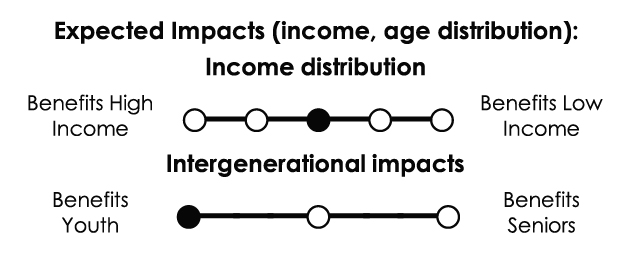
GBA+ Responsive Approach
To support greater diversity and inclusion, the Global Talent Stream encourages employers to commit to a more diverse workforce as part of their Labour Market Benefits Plan. To date, approximately 20 per cent of employers have committed to activities that would support the skills development and hiring of underrepresented groups, including Indigenous youth, persons with disabilities and newcomers.
GBA+: Chapter 2
Building a Nation of Innovators
Improving Support for Small, Growing Companies
- $395 million over five years to support growing, innovative businesses.
The Scientific Research and Experimental Development (SR&ED) tax incentives provide tax relief for businesses of all sizes conducting research and development (R&D) in all sectors of the economy. This measure will improve access to the enhanced SR&ED tax credit for growing, innovative businesses, encouraging incremental investments in R&D.
Over time, the economic growth resulting from a more innovative and productive Canada is expected to raise standards of living for all Canadians.
Incremental R&D investment is expected to increase Canada’s productivity—not only for the business performing the R&D, but also for the economy more widely, as there are substantial knowledge spillovers associated with early-stage innovation.
In the short run, the measure may have a more significant impact on men as corporate ownership and employment in the sectors that most benefit from this incentive are not gender-balanced. With respect to corporate ownership, men receive a larger share of overall dividend payments (60 per cent). With respect to the performing sector, more than 40 per cent of the benefits are expected to accrue to the professional, scientific and technical services sector, where women account for less than half (43 per cent) of total employment and Indigenous peoples account for 1.6 per cent of employment in this sector, compared to 3.0 per cent of employment across all industries.
GBA+ was performed: On the existing program
Target population: All Canadians; growing, innovative small and medium-sized businesses


GBA+: Chapter 2
Building a Better Future for Canada's North
Supporting the Next Generation of Entrepreneurs
- $38 million over five years to Futurpreneur Canada to support the next generation of entrepreneurs, including $3 million specifically targeted to increase support to Indigenous entrepreneurs.
Futurpreneur Canada's programing is designed to directly benefit Canadian entrepreneurs between 18-39 years. Young entrepreneurs often do not have business experience and assets and as a result, their ventures are often deemed too high-risk and time-consuming for traditional lenders.
As an organization, Futurpreneur Canada has worked to overcome systemic barriers faced by women entrepreneurs and in 2017–18 over 40 per cent of the businesses supported by Futurpreneur Canada were owned by women, more than double the national average.
Renewed federal funding for this organization will allow Futurpreneur Canada to support more young entrepreneurs in bringing their ideas to market. In particular, new funding targeting Indigenous entrepreneurs is expected to allow Futurpreneur Canada to engage up to 7,250 Indigenous youth through outreach, access to business support tools and training, as well as support up to 175 additional Indigenous businesses.
GBA+ was performed: On the existing program
Target population: Canadian entrepreneurs aged 18 to 39



Increased opportunities for women to start and grow their businesses, and succeed on a global scale
GBA+ Responsive Approach
Futurpreneur Canada’s initiatives are designed to directly benefit individuals aged 18 to 39 seeking entrepreneurship as a career path, as this cohort is underserved by traditional lenders. Within this cohort, Futurpreneur Canada has, and is continuing to undertake initiatives to target underrepresented groups. For example, female entrepreneurs face unique barriers as they move along the business cycle. As a result, they own fewer than 16 per cent of businesses in Canada and are underrepresented in our economy. Futurpreneur Canada has targeted marketing and initiatives in place to help mitigate the barriers faced by young female entrepreneurs and encourage more young women to pursue carriers in entrepreneurship. As a result, in 2016-17, 40 per cent of businesses supported by the organization were majority-owned by women, showing positive results from gender-targeted outreach.
GBA+: Chapter 2
Building a Nation of Innovators
Helping Canada's Forest Sector Innovate and Grow
- $251.3 million over three years, starting in 2020–21, to support further forest sector innovation to capitalize on opportunities in the bioeconomy.
The Canadian forest sector plays a significant role in the economic well-being of numerous rural and remote communities, including Indigenous communities, while also supporting the Government’s commitments to mitigating climate change. The forest sector is well-represented across all regions of Canada, except in the territories (52 per cent of sector employment is in Ontario and Quebec, 39 per cent in Western Canada and the prairies, 9 per cent in Atlantic Canada).
Renewing funding for programs that promote innovation and open markets for Canadian wood fibre promotes the health of the forest sector.
Forest sector employees are more likely to be older men, but supporting increasing innovation and technology adoption within the industry will result in more knowledge-based occupations (e.g., science, engineering) and can lead to greater participation by women and other currently underrepresented groups (including new Canadians).
Further private investment in the sector will result in broad benefits for the more than 70 per cent of Canadian Indigenous communities located within forested areas, along with the more than 100 (predominantly rural) communities where the sector is a significant part of the economy.
GBA+ was performed: On the existing program
Target population: Forest sector workers and residents of forest-reliant communities


GBA+ Responsive Approach
Participation of different groups of Canadians will be tracked by beneficiaries and delivery agents of the programs. Further measures will be developed to consider strategies to increase the participation of underrepresented groups in the forest sector, in project selection and results tracking in specific federal forest programs.
The Forest Products Association of Canada has set an industry recruitment goal to include more women, Indigenous peoples and new Canadians.
GBA+: Chapter 2
Building Science Excellence in Canada
Supporting Innovation in the Oil and Gas Sector Through Collaboration
- $100 million over four years, starting in 2019–20, to support the Clean Resource Innovation Network through the Strategic Innovation Fund.
The Strategic Innovation Fund provides support to firms of all sizes, as well as networks and consortiums made up of industry, academic institutions, research institutes and not-for-profit entities. The Fund is available across all of Canada’s economic sectors. Projects are assessed and selected based on innovation, economic and public benefits.
The Clean Resource Innovation Network is a consortium working to accelerate the development and adoption of innovative oil and gas technologies and processes that seek to lower the industry’s environmental impacts and enhance its competitiveness. When developing technology research and adoption projects, the Network includes criteria related to gender balance and diversity.
Workers in the oil and gas sector, and the science and research sector are typically predominantly men relative to the broader Canadian workforce. For example, according to the Government of Alberta, in 2017, Albertan women accounted for 21.5 per cent of total employment in the mining and oil and gas extraction industry. Women also make up only one-fifth of individuals with a doctorate in science, technology, engineering and mathematics fields.
According to a study by PetroLMI, a Division of Energy Safety Canada (Diversifying Canada’s Oil and Gas Workforce—A Decade in Review, 2018), in 2016, Indigenous peoples made up 6.3 per cent of Canada’s oil and gas sector workforce compared to 3.9 per cent of the total Canadian workforce.
GBA+ was performed: Early in the idea development phase
Target population: Workers, rural communities and businesses; science and research sector and oil and gas sector


GBA+ Responsive Approach
In terms of public benefits, the Strategic Innovation Fund’s project assessment framework considers contributions to the broader public good, including gender balance and impact on Indigenous communities. The Clean Resource Innovation Network is committed to ensuring that gender and diversity are considered as part of its technology research and adoption projects. The Strategic Innovation Fund will monitor how benefits accrue to different gender and demographic groups in the context of its support to the Clean Resources Innovation Network.
GBA+: Chapter 2
Investing in Other Regional Priorities
Western Economic Diversification Canada
- $100 million over three years, starting in 2019–20, to Western Economic Diversification Canada to increase its programming in western Canada.
Western Economic Diversification Canada promotes the development and diversification of the economy in the western provinces including British Columbia, Alberta, Saskatchewan, and Manitoba.
The agency works to enhance innovation, improve business competitiveness, and promote the adoption of clean technologies. Approximately 11.1 million people, roughly 32 per cent of Canadians, call western Canada home including over half of Canada’s Indigenous population.
Western Economic Diversification Canada provides support to not-for-profit organizations and to innovative small and medium-sized businesses. According to Statistics Canada, the western provinces have a higher prevalence of women-owned enterpreses relative to the rest of Canada.
GBA+ was performed: On the existing program
Target population: Western Canada


GBA+ Responsive Approach
GBA+: Chapter 2
Building a Nation of Innovators
Launching a Federal Strategy on Jobs and Tourism
- $58.5 million over two years, starting in 2019–20 to create a Canadian Experiences Fund to improve or expand tourism infrastructure and products.
- $5 million to launch a domestic tourism marketing campaign to introduce Canadians to lesser known areas and help boost regional development.
- The creation of a seventh Economic Strategy Table dedicated to unlocking the potential of Canada’s tourism sector.
Tourism is an important contributor to Canada’s economy, representing about 2 per cent of the country’s GDP and employing over 750,000 people, including a large number of women, youth, Indigenous, immigrants and LGTBQ2 Canadians.
Women occupy 51.4 per cent of total jobs in the tourism sector, compared to 48.2 per cent across all industries. Visible minorities also make up 27.5 per cent of tourism workers, compared to 21.3 per cent across all sectors. In addition, Indigenous people make up 4.1 per cent of the tourism workforce, compared to 3.7 per cent across all industries.
These groups are also more likely to own a tourism business than in other sectors. For example, women business ownership is higher in tourism SMEs (21.2 per cent) compared with the average of all industries (15.7 per cent)—although tourism SMEs are still predominately owned by men.
As the initiative is focused on strengthening Canada’s tourism sector by creating awareness and improving tourism experiences, the activities stand to benefit underrepresented groups in the tourism sector and support regional growth and the Government’s commitment to create middle class jobs.
GBA+ was performed: Early in the development phase
Target population: Tourism sector


GBA+ Responsive Approach
GBA+: Chapter 2
Building a Nation of Innovators
Canada Reaches for the Moon and Beyond
- $2.05 billion over 24 years, to ensure that Canada continues to be a leader in space robotics.
Canada is an internationally recognized leader in space robotics and is well-suited to providing next-generation robotics for the NASA-led Lunar Gateway. It is also well-positioned to contribute robotics and rover technologies to other space-faring nations' space missions. The know-how that is generated through these investments, particularly investments in a next-generation Canadarm, will permit Canadian companies to lead in the emerging commercial space market.
The space sector is a science, technology, engineering, and mathematics (STEM) intensive sector -- as a result, the anticipated increase in these types of jobs is expected to directly benefit men more given that they are more likely to have pursued studies and be employed in these areas. For example, approximately 20 per cent of workers are women in the aerospace products and parts manufacturing sector, which includes both space and non-space aerospace manufacturing.
The potential applications of these investments on Earth are also considerable; for example, the development of previous Canadarm technology led to the creation of the world's first robot capable of performing surgery inside magnetic resonance machines. The unique laboratory environment that the Lunar Gateway provides can also be used as a platform to study the effects of ageing in an accelerated fashion. This is expected to benefit both elderly men and women, as health studies have in the past examined changes in bone and marrow density, cardiovascular health, eyesight, and diabetes.
Canada's investment in the next generation of space robotics and applied artificial intelligence will open opportunities for additional space flights for Canadian astronauts, serving as inspiration for young Canadians to chose STEM as a field of post-secondary study. This investment will also include a youth promotion program to inspire young Canadians to pursue studies in STEM so that the next generation can contribute to Canada's activities in space.
GBA+ was performed: Mid-point
Target population: All Canadians; Space sector companies and employees


GBA+ Responsive Approach
GBA+: Chapter 2
Building a Nation of Innovators
Bringing Innovation to Regulations
- $219.1 million over five years (with $0.5 million in remaining amortization) and $3.1 million in ongoing funding for the implementation of the Regulatory Roadmaps and to support regulatory cooperation activities.
Budget 2019 announces the completion of the first three "Regulatory Roadmaps" in the following high-growth sectors:
- Agri-food and aquaculture.
- Health and bio-sciences.
- Transportation and infrastructure.
The Roadmaps contain proposals for legislative and regulatory amendments as well as novel regulatory approaches to accommodate emerging technologies.
The Roadmaps are expected to broadly improve the health and transportation safety of all Canadians. In particular, the Roadmaps will ensure that Canadians continue to have access to safe and nutritious food; increased access to beneficial health products; and the continued development of a modern, proactive, aligned transportation regulatory framework that ensures safety and security for Canadians.
A significant group of indirect beneficiaries would be workers in the affected high-growth sectors. For the healthcare sector, professional support workers and informal caregivers are expected to benefit in particular through increased access to beneficial health products for Canadians and increased oversight of available products. Approximately 92 per cent of professional support workers are women, and approximately 54 per cent of informal caregivers are women. As well, workers in the transportation sector tend to be predominantly men and according to the 2016 Census of Agriculture, 29 per cent of farm operators were women.
GBA+ was performed: On the existing program
Target population: All Canadians


GBA+: Chapter 2
Building Research Excellence in Canada
Stem Cell Network
- $18 million over three years in renewed support for the Stem Cell Network.
Stem cells have the potential to differentiate into any cell type and can renew themselves, whichs means they can heal blood, tissue and organs. Regenerative medicine depends on stem cell research to discover better ways of helping people. Stem cell therapies are already used to treat blood cancers and multiple sclerosis, and hold promise to one day treat more diseases and conditions, such as type 1 diabetes, heart and kidney diseases, other types of cancer, and neurological diseases.
The Stem Cell Network has forged a national stem cell community, and acts as a catalyst for enabling the translation of stem cell research into clinical applications, commercial products and public policy. The work of the Stem Cell Network has the potential to improve the lives of many Canadians living with health issues.
The Stem Cell Network awards funding to researchers at Canadian universities, research hospitals and not-for-profit research institutions on the basis of research excellence through a competitive peer review process. Although the Stem Cell Network seeks to ensure that funding is provided on an equitable basis, there is a lower proportion of women in leading stem cell research positions in Canada relative to men. For research awards made by the Stem Cell Network in 2016, women represented 35 per cent of principal investigators and 31 per cent of co-investigators.
GBA+ was performed: On the existing program
Target population: All Canadians; science and research sector


GBA+ Responsive Approach
GBA+: Chapter 2
Building Research Excellence in Canada
Brain Canada Foundation
- $40 million over two years in support of the Brain Canada Foundation’s Canada Brain Research Fund.
Brain disorders and diseases include neurological diseases such as multiple sclerosis, amyotrophic lateral sclerosis, Parkinson's disease and brain tumors, among others. They also include neuropsychiatric disorders, which are mental disorders attributable to diseases of the nervous system, such as schizophrenia and depression. The burden of neurological disease is expected to increase as the population ages.
The Brain Canada Foundation is a national charitable organization that raises funds to foster advances in neuroscience discovery research, with the aim to enhance understanding and improve health care for Canadians affected by neurological injury and disease. According to the Brain Canada Foundation, one in three Canadians will face a psychiatric disease, a neurological disorder or a brain or spinal cord injury at some point in their lives.
The Foundation’s Canada Brain Research Fund provides grants for brain research, fosters research collaboration and stimulates innovation in prevention and treatment. All research grants are awarded based, first and foremost, on scientific merit. There is a lower proportion of women among grantees relative to men. According to the Brain Canada Foundation's performance reports, in 2017-2018, approximately 42 per cent of the grant opportunities provided through the Canada Brain Research Fund were awarded to women and 58 per cent were allocated to men.
GBA+ was performed: On the existing program
Target population: All Canadians; science and research sector


GBA+ Responsive Approach
GBA+: Chapter 2
Building Research Excellence in Canada
Terry Fox Research Institute
- $150 million over five years to the Terry Fox Research Institute to help establish a national Marathon of Hope Cancer Centres Network.
The Terry Fox Research Institute, the research arm of the Terry Fox Foundation, seeks to enable the translation of cancer research discoveries into practical solutions for cancer patients. The Institute collaborates with over 70 cancer hospitals and research organizations across Canada.
According to the Canadian Cancer Society, 103,100 Canadian men and 103,200 Canadian women were diagnosed with cancer in 2017. Cancer is a disease that mostly affects Canadians aged 50 and older, but it can occur at any age.
Budget 2019 proposes to support the Terry Fox Research Institute in its efforts to establish a national Marathon of Hope Cancer Centres Network to facilitate collaboration and the sharing of information and data among cancer researchers, and to position Canada as a leader in precision medicine in cancer diagnosis and treatment.
Although the Network will be set up to ensure diverse groups of men and women have access to its activities, fewer women than men continue their studies at progressively higher levels of education in many fields of study, and therefore women are underrepresented in the pool of researchers eligible for support in Canada. Women make up only one-fifth of individuals with a doctorate in science, technology, engineering and mathematics fields.
GBA+ was performed: Early in the idea development phase
Target population: All Canadians; science and research sector


GBA+ Responsive Approach
GBA+: Chapter 2
Building Research Excellence in Canada
Ovarian Cancer Canada
- $10 million over five years to support Ovarian Cancer Canada in helping address gaps in knowledge about effective prevention, screening, and treatment options.
Ovarian cancer is a disease that is exclusive to women. According to the Canadian Cancer Society, an estimated 2,800 Canadian women were diagnosed with ovarian cancer in 2017. Ovarian cancer is the fifth most common cancer for women, and the most deadly. The risk of ovarian cancer increases with age, a disease that is more common among women aged 50 to 79.
Ovarian Cancer Canada supports women living with the disease and their families, raises awareness among the general public and health care professionals, and funds research to develop early detection techniques, improved treatments and, ultimately, a cure.
Guided by a committee comprising leading scientists, clinicians, and people who have been personally affected by the diseases, Ovarian Cancer Canada’s research strategy focuses on building capacity and advancing knowledge.
Launched by Ovarian Cancer Canada in September 2017, OVdialogue is a new online community where women with ovarian cancer can get to know one another and band together for support in confronting this disease.
GBA+ was performed: Early in the development phase
Target population: Women affected by ovarian cancer and their families; science and research sector
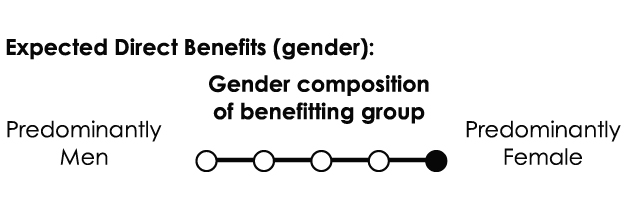
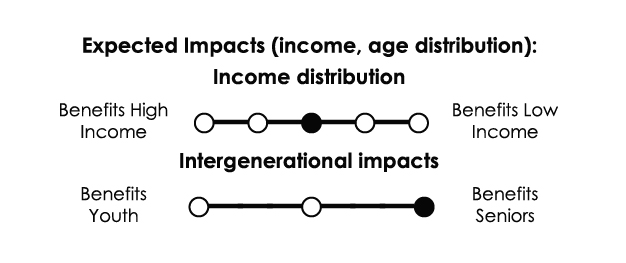
GBA+: Chapter 2
Building Research Excellence in Canada
Genome Canada
- $100.5 million over five years in support for Genome Canada’s operations and large-scale research competitions and projects.
Genomics is the science that aims to decipher and understand the entire genetic information of an organism (i.e., human, animal, plant or microorganism) encoded in its DNA. Genomics has broad applications across a number of sectors that affect the lives of Canadians, including health, agri-food, natural resources and the environment.
Genome Canada is the primary organization in Canada responsible for national support of large-scale genomics research in Canadian universities, research hospitals and not-for-profit research organizations, in part through its support of six regional Genome Centres (British Columbia, Alberta, Prairies, Ontario, Quebec and Atlantic).
Through large-scale research projects, Genome Canada seeks to generate transformative scientific breakthroughs and translate these discoveries into solutions and technologies that create economic and social benefits for Canadians.
Although the program is set up to ensure diverse groups of men and women have equal access to research awards, which are provided on the basis of research excellence through a merit review and competitive process, genomics is a field that has typically been dominated by men. According to Genome Canada’s 2017-2018 Annual Report, 81 per cent of project leads and co-leads engaged in active research projects in 2017–18 were men; 55 per cent of research project review panels were men; and 46 per cent of its Board of Directors were men.
GBA+ was performed: On the existing program
Target population: All Canadians; science and research sector


GBA+ Responsive Approach
GBA+: Chapter 2 Let's Talk Science engages youth in STEM, introducing them to critical skills development opportunities and opening doors to future studies and occupations. These activities help ensure groups that are underrepresented in STEM (such as girls and
Indigenous youth) gain and maintain interest in STEM from an early age. In 2011, women accounted for 39 per cent of university graduates aged 25 to 34 with a STEM degree, compared with 66 per cent of university graduates in non-STEM programs.
The direct benefits of Let's Talk Science are expected to accrue broadly to Canadian youth in the form of learning and interest-building activities. In 2017-18, Let's Talk Science engaged 300,000 youth, including over 16,500 Indigenous youth.
Approximately 65 to 70 per cent of Let's Talk Science's volunteers are women, the majority of whom are studying STEM. They will also receive benefits in the form of opportunities that develop fundamental skills (such as networking and engagement)
and experiences that may increase their employability. GBA+ was performed: Mid-point Target population: Youth More diversified educational paths and career choices By ensuring girls are engaged in STEM interest-building activities, Let's Talk Science will help increase the enrollment of women
in STEM post-secondary programs and occupations. By providing programs that are free to participants, the organization is ensuring that income level is not a barrier to participation. Let's Talk Science works to engage youth in all regions
of Canada, including remote, northern and Indigenous communities. GBA+: Chapter 2 TRIUMF is owned and operated as a joint venture by a consortium of 20 Canadian universities and is home to more than 500 staff and students. The funding will be used for the operation of TRIUMF's facilities, including maintenance and upgrades,
as well as the salaries and benefits of TRIUMF employees. These employees are predominantly men and highly educated. Men compose 81.5 per cent of TRIUMF's total employees, and 86.7 per cent of its science, technology, engineering and mathematics employees. TRIUMF performs health-related research around four over-arching areas affecting Canadians today—cancer, cardiovascular disease, neurodegenerative disease and metabolic disorders—and maintains Canada's only proton therapy facility which is used
to treat patients with ocular melanoma. TRIUMF is performing radiopharmaceutical work for the imaging and/or treatment of prostate, breast, lung, colorectal, lymphoma, melanoma, ovarian and pancreatic cancers. According to the Canadian Cancer
Society, these cancers account for over half of all new projected cancers that will afflict both men and women. Isotopes produced by TRIUMF can be used in the treatment and diagnosis of a variety of diseases, with the precise application determined by TRIUMF's clinical partners. Some applications can have significant differential impacts across men and
women (i.e., prostate, breast and/or ovarian cancer), while others do not. GBA+ was performed: On the existing program Target population: All Canadians; science and research sector GBA+: Chapter 2 Canada has world-leading non-profit organizations that undertake research and bring together experts from various backgrounds to make discoveries, accelerate innovation and tackle health challenges. To improve the adaptability and effectiveness of federal funding for third-party science and research organizations, Budget 2019 proposes to establish a new Strategic Science Fund. This new fund will include a principles-based framework for allocating
funding through a competitive, transparent process that focuses on research excellence and equitable support for highly qualified Canadian researchers in a way that minimizes potential gender bias. However, because fewer women than men continue their studies at progressively higher levels of education in many fields of study, women tend to be underrepresented among researchers typically eligible for research support. In humanities studies,
women make up 64 per cent of bachelor's degree holders, but only 41 per cent of doctorate holders. Women make up only one-fifth of individuals with a doctorate in science, technology, engineering and mathematics fields. Approximately 60 per cent of university faculty in Canada are men, according to November 2017 Full-time University and
College Academic Staff System survey results. GBA+ was performed: Early in the development phase Target population: All Canadians; science and research sector
Building Research Excellence in Canada
Let's Talk Science



GBA+ Responsive Approach
Building Research Excellence in Canada
Strengthening Canada's World-Class Physics Research


GBA+ Responsive Approach
Building Research Excellence in Canada
Taking a New Approach with the Strategic Science Fund


GBA+ Responsive Approach
This Strategic Science Fund's principles-based framework will be applied by an independent panel of experts, including scientists
and innovators, to provide advice to the Government on the allocation of funding to third-party science and research organizations. The Government will ensure that representation on this panel is gender-balanced and diverse. This principles-based
framework will also include gender, diversity and inclusivity criteria that will be applied to all organizations seeking support.
- Date modified: